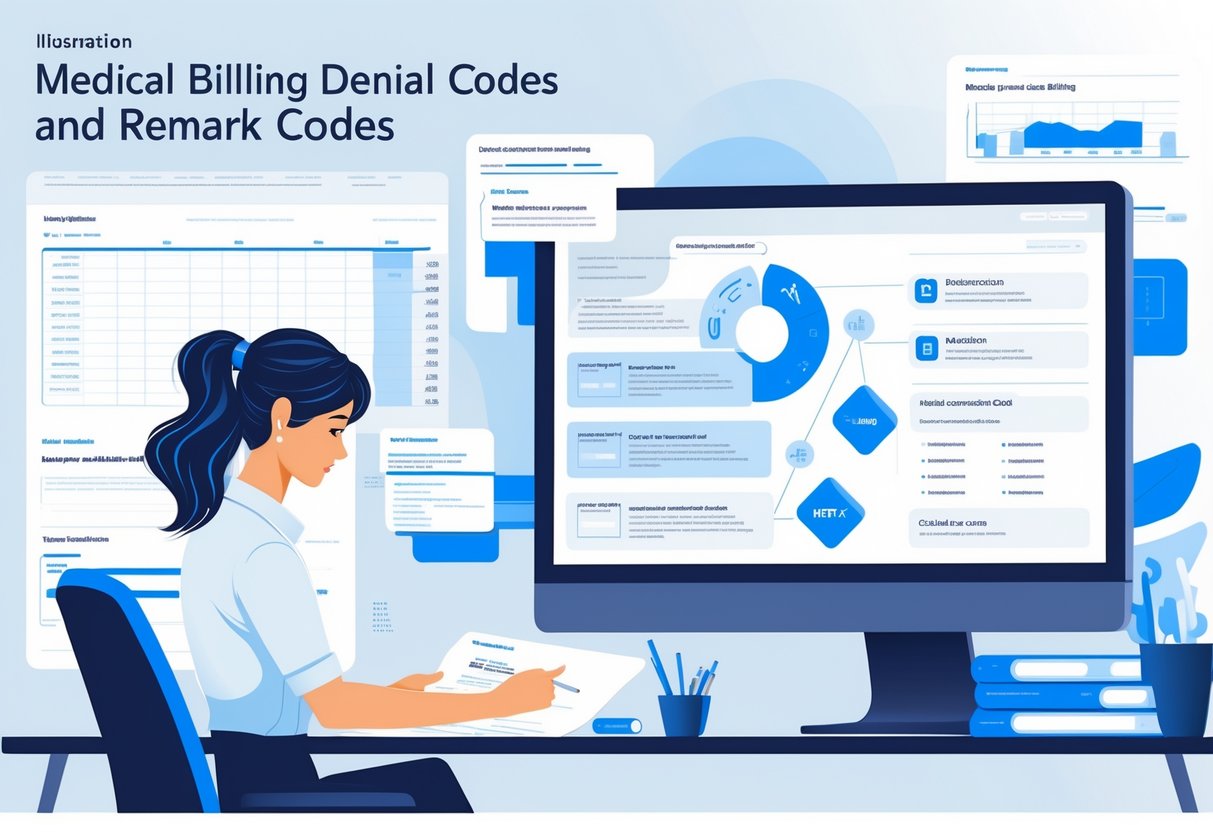Denial code 96 means your claim includes a charge that is not covered by the insurance plan. When you see this code, it means at least one Remark Code must be given to explain the reason. The Remark Code can come from either the NCPDP Reject Reason Code or the Remittance Advice Remark Code, as long as it is not an ALERT.
Understanding this denial code helps you know why a claim was denied and what information is missing or needed. This can save you time and help you fix the issue more quickly. Knowing how to read and respond to Remark Codes is key when dealing with denial code 96.
Understanding Denial Code 96

Denial Code 96 means a charge is not covered by the insurance plan. It requires a specific Remark Code to explain why the charge is denied. This helps you understand what non-covered service or item caused the denial and how to handle it.
Definition and Scope
Denial Code 96 points to a non-covered charge on a claim. This means the insurance will not pay for the service or item because it is outside the plan’s coverage.
You must provide at least one Remark Code with this denial. The Remark Code explains why the charge is non-covered. This code can be a NCPDP Reject Reason Code or a Remittance Advice Remark Code but cannot be an ALERT type.
This denial applies to non-covered services that the payer views as excluded or ineligible for reimbursement under your patient’s insurance rules. It makes clear that the charge is not a billing error but an issue with coverage.
Common Scenarios and Examples
You may see Denial Code 96 in cases like:
- A requested test or procedure not covered under the patient’s health plan.
- A service categorized as experimental or investigational.
- Supply or drug excluded by policy terms.
For example, if you submit a claim for a cosmetic procedure that is not covered, denial code 96 will be triggered. The accompanying Remark Code will specify the reason, such as “service not covered”.
Another example is when durable medical equipment is denied because it is considered non-essential or beyond policy limits.
Distinction From Other Denial Codes
Denial Code 96 is about non-covered services, not billing errors or authorization problems.
Unlike denials for incorrect coding or missing information, Code 96 confirms the service is excluded from payment by policy terms.
Other denials may point to claim data issues, but Code 96 focuses solely on coverage rules.
It is important to look at the Remark Code with it because denial Code 96 alone doesn’t explain why the service is non-covered. The remark details help you decide if you should appeal or inform the patient about potential costs.
Key Codes and Components

Understanding the codes involved in denial code 96 helps you identify why a charge is non-covered. This includes specific remark codes used to pinpoint the reason for denial, which come from different sources, each with a distinct role.
Role of Remark Codes
Remark codes provide detailed reasons for claim denials or adjustments. When you see denial code 96, at least one remark code must be included. These codes explain why a charge is non-covered and guide you in fixing the issue.
Remark codes can appear in the service payment information section of your healthcare claim. They are essential because they clarify the payment decision made by the payer. Without a remark code, you might not know the specific reason for denial or how to appeal.
You rely on these codes to quickly understand denials. Proper use ensures your claims are complete and follow payer rules, reducing delays or rejections.
NCPDP Reject Reason Codes Clarified
NCPDP reject reason codes come from the pharmacy industry. They explain why a pharmacy claim was rejected during billing or adjudication.
For denial code 96, the NCPDP reject reason code must not be an alert. This code points to specific issues like coverage limits or incorrect billing. You find these codes in electronic pharmacy claim responses.
They help you identify if the non-covered charge happened due to policy limits or errors in the submitted claim. Using the NCPDP reject reason code allows you to address problems quickly and correctly.
Remittance Advice Remark Codes Explained
Remittance Advice Remark Codes (RARCs) are part of the 835 healthcare policy identification segment. They give detailed information about why a service or charge was denied or adjusted.
When dealing with denial code 96, you must provide at least one RARC that is not an alert. These codes help you understand payer policies affecting your claim.
RARCs are standardized and widely used across different payers. They include information about contract limitations, patient responsibility, or service exclusions. These remarks help you interpret the payment decision properly and plan your next steps.
Root Causes and Prevention
Denial code 96 happens when a charge is not covered by the insurance plan. To avoid this, you need to confirm coverage, get necessary approvals, and use the right billing codes.
Insurance Coverage Verification
You must verify insurance coverage before submitting claims. Check the patient’s plan details to see if the service or item is covered.
Use payer portals, phone calls, or electronic verification tools to confirm eligibility and benefits. This step helps catch non-covered charges early.
Make sure you document the verification date, time, and agent name. This information supports your case if a denial occurs.
Always confirm active coverage on the service date. Coverage might change between visits, so don’t rely on past checks.
Prior Authorization Requirements
Some services require prior authorization, meaning you need permission from the insurer before delivering care.
To avoid denial code 96, obtain this approval in advance. Submit the right forms with accurate patient and service details.
Keep track of authorization numbers and expiration dates. Submit claims with these numbers attached to show compliance.
If you skip or delay prior authorization, the insurer may reject the charge as non-covered.
Incorrect Coding and Modifiers
Incorrect or missing coding causes denials. You must use the proper procedure and diagnosis codes.
Also, apply modifiers correctly to explain special situations (e.g., multiple procedures, services by different providers).
Review coding guidelines regularly and ensure your billing team updates codes on time.
Incorrect modifiers can make a covered service appear non-covered, triggering denial code 96.
Use coding software or audits to double-check your submissions before sending claims.
Impact on Billing and Claims
You must track denial code 96 carefully to prevent lost payments and claim confusion. This code signals charges that are not covered, requiring remark codes to explain why. Handling this right affects your billing accuracy, coordination of benefits, and service payment information.
Coordination of Benefits Challenges
Denial code 96 often arises when there are issues with coordination of benefits (COB). If a service is covered by one insurance plan but not another, you must correctly report which plan is primary. Missing or incorrect remark codes can delay claims or cause denials.
You’ll need to verify coverage details to identify non-covered charges. This helps avoid situations where a second insurer rejects a claim because the primary insurer did not process it properly. Accurate documentation and remark codes improve the coordination process.
Billing Errors and Claim Denials
This denial often happens due to billing errors like submitting charges for services that the payer excludes. If you don’t include the required remark code explaining why the charge is non-covered, the claim will deny.
You should double-check diagnosis codes and billing entries before submission. Mistakes in these areas can trigger denial code 96 and cause payment delays. Clear, correct documentation reduces the chance of claim rejections.
Service Payment Information Review
Denial code 96 also means you must review the service payment information carefully. The payer is indicating that some charges on your claim are not covered under the patient’s plan.
You should analyze the claim details to determine which service lines are non-covered. Including the proper remark code clarifies what part of the charge is rejected. This review is key to submitting corrected claims and receiving proper payment.
Resolution Steps and Best Practices
Dealing with Denial Code 96 requires clear communication and careful handling of the appeal process. Keeping accurate records and providing the right documentation will help you respond efficiently and reduce delays.
Communicate Effectively With Payers
When you contact payers about Denial Code 96, make sure you have all necessary claim details ready, including the denial reason and any remark codes provided. Be precise and ask for specific information on why the charge is non-covered.
Use clear language and avoid assumptions. Confirm whether the payer requires additional documentation or corrections before resubmitting the claim. Keep a log of all communications, including phone calls and emails, noting times, contacts, and what was discussed.
Maintaining professional and consistent follow-up can speed up resolution. If the payer updates their policies or codes, update your team to prevent repeated denials.
Appeal Process For Denial Code 96
If you believe a charge should be covered, prepare to file an appeal swiftly. First, gather all supporting documents like patient records, treatment plans, and payment policies.
Follow the payer’s appeal guidelines carefully. Submit your appeal within the required time frame. Include the denial code, remark codes, and a clear explanation of why the charge qualifies for coverage.
Track your appeal status regularly and be ready to provide additional information if requested. Persistence is key, but avoid submitting duplicate appeals unless new evidence is available.
Documentation and Recordkeeping Tips
Accurate and organized records are essential when managing Denial Code 96. Keep copies of all remittance advices, claim submissions, and payer correspondence in one secure place.
Use checklists to verify that every claim includes the necessary remark codes and explanations. This prevents errors and simplifies review during audits or appeals.
Recording the date and outcome of each communication or appeal helps you manage timelines and ensures you meet payer deadlines. Digital tools can help you automate reminders and document storage to improve efficiency.
Frequently Asked Questions
Denial code 96 means a charge is not covered by the insurance plan. You need to check specific remark codes that explain why the charge was denied and figure out how to respond based on those details.
How can one resolve a CO 96 denial code when processing insurance claims?
You should review the remark codes provided with the denial. These codes explain why the charge was not covered.
Contact the insurance payer for clarification if the reason is unclear. You might need to update the claim or get additional documentation.
What does it mean when a charge is denied as non-covered with a PR 96 code?
PR 96 indicates the patient is responsible for the denied charge. The service is not covered by the insurance plan.
You should inform the patient about their financial responsibility. Make sure to explain the reasons behind the denial.
What steps should be taken when receiving a denial code 96 due to non-covered services?
Check the service or procedure against the patient’s benefits to confirm coverage.
Verify if the service requires prior authorization or has special conditions.
Submit appeals or adjustments only if coverage should apply.
How is patient responsibility determined in the context of CO 96 and PR 96 denial codes?
CO 96 shows the service is non-covered by the payer. PR 96 assigns the cost to the patient.
You must communicate to patients that these codes mean their insurance will not pay, and they owe the full amount.
What are the implications of N425 and N130 denial codes in relation to non-covered charges?
N425 means the service is not covered as it is considered part of another procedure. N130 means the service is excluded from benefits.
Both codes justify denial code 96. They help explain why a charge can’t be paid by insurance.
Why might a colonoscopy result in a denial code 96 and what does this indicate about coverage?
A colonoscopy may get denied if done for screening without symptoms and the plan excludes this service.
It shows your insurance plan does not cover that type of colonoscopy under the current policy terms. You should confirm coverage rules with your insurer.







